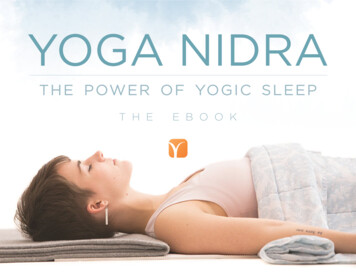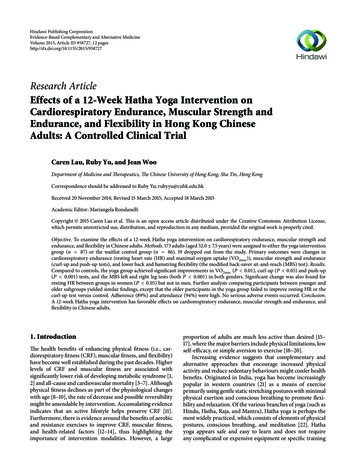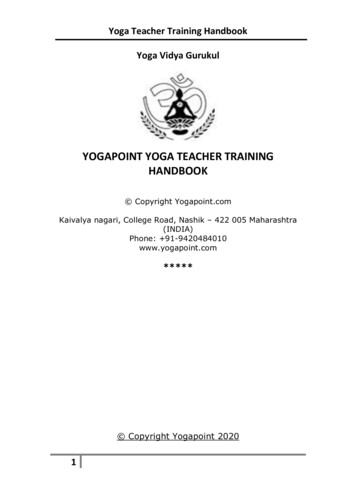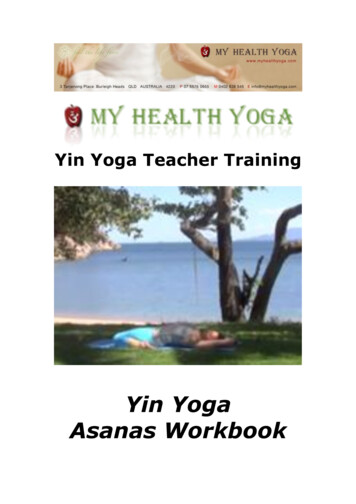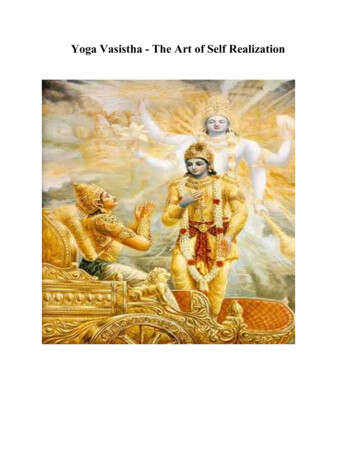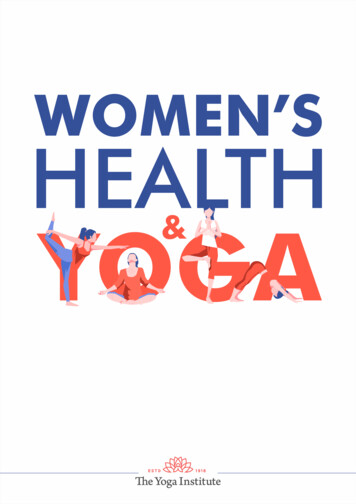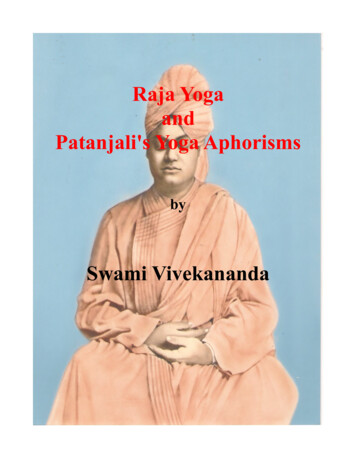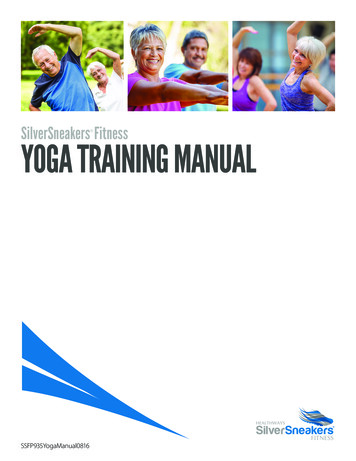
Transcription
SilverSneakers Fitness YOGA TRAINING MANUALSSFP935YogaManual0816
TABLE OF CONTENTSProgram Overview. 2SilverSneakers Yoga. 3Class Guidelines and Format. 4Five-Segment Class Format. 6Yoga Postures.10Bibliography .13INTERNAL USE ONLY 2016 Healthways, Inc. All rights reserved. 1
Program OverviewOur mission is to improve the health and well-being of everyone we touch. We do this by providingunique older adult fitness programming to eligible health plan members nationwide. Thesemembers receive basic access to any participating location in our SilverSneakers network, most ofwhich offer our signature classes.SilverSneakers signature group exercise classes are multi-level and equipment-based. Theyare designed to be appropriate for both sedentary and active Medicare-eligible individuals,and welcome persons of all skill levels and abilities while fostering a safe and positive socialatmosphere. The true goal of our class formats is to help participants to perform better andmore confidently the necessary activities of daily living (ADLs). We achieve this goal by targetingincreases in muscular strength, cardiovascular endurance and flexibility.We are glad that you have decided to learn more about SilverSneakers and hope that you’llcontinue to share your passion for healthy living with the eligible members who visit yourlocation. We welcome you to a nation-wide community of instructors committed to maintainingthe highest standards of exercise participation and retention in the fitness industry.INTERNAL USE ONLY 2016 Healthways, Inc. All rights reserved. 2
SilverSneakers YogaWhat is SilverSneakers Yoga?SilverSneakers Yoga is an older adult group exercise that specifically targets flexibility, range ofmovement, balance and mind-body integration. While not required by contract, we recommend allparticipating locations offer one or more Yoga classes per week in addition to Classic, Cardio, Circuitand Splash.SilverSneakers Yoga is a blend of Vinyasa Yoga, Viniyoga and Iyengar Yoga. Vinyasa Yoga combinesposes into a flowing series that creates warmth and energy within the body. Viniyoga is a therapeuticstyle that adapts poses to an individual’s needs. Iyengar Yoga is a technically-correct style thatfocuses on precise alignment and posture. SilverSneakers Yoga also incorporates more traditionalstretching exercises for a variety of movement options.SilverSneakers Yoga is appropriate for every “body.” The class offers light- to moderately-intenserhythmic and static range of movement choreography and progressive breathing exerciseinstruction. Be prepared to accommodate any participant regardless of disability or skill set.SilverSneakers Yoga Goals and BenefitsOur goals in SilverSneakers Yoga are to: Increase flexibility and range of movement Improve balance and core strength Increase muscular endurance Reduce stress Use the breath more effectively Improve an individual’s sense of well-being in a group settingThe numerous benefits of this universally-accessible format include: Improved posture Increased flexibility and strength Better balance and stability Maintenance of bone strength Decreased back pain Improved digestion and elimination Improved circulation and respiration Strengthened immune system Improved sleep Greater body awareness, appreciation and acceptance Elevated mood, and better mental clarity and function Integration of body, mind, and breathINTERNAL USE ONLY 2016 Healthways, Inc. All rights reserved. 3
Class Guidelines and FormatClass DescriptionParticipating locations must follow SilverSneakers’ brand usage guidelines on all printed materials.Please duplicate the following class description on your group exercise schedule:SilverSneakers YogaSilverSneakers Yoga will move your whole body through a complete series of seated and standing yogaposes. Chair support is offered to safely perform a variety of postures designed to increase flexibility,balance and range of movement. Restorative breathing exercises and a final relaxation will promote stressreduction and mental clarity.Equipment and Setup SilverSneakers Yoga is a 45- to 60-minute class and must be taught in a room with a controlled environmentappropriate for group exercise instruction. We recommend a minimum of 16 square feet of spaceper person.Every participant must have a SilverSneakers chair for seated and standing support. Elastic tubing withhandles and the SilverSneakers ball may provide balance and stretching assistance as needed.Participants face the front of the room or face the instructor directly in a semicircle. Never positionparticipants in a circle for class and risk sustained cervical rotation. Teach from a standing position and try tochoose different positions in the front of the room to maximize visual contact.SilverSneakers Yoga utilizes a modified perceived exertion chart, available on your PL Provider Portal. Ensurethat this chart will be visible to all participants for the duration of class.Music for SilverSneakers Yoga should create a relaxing atmosphere. Therefore, beat-driven “workout” music isnot typically used in this class.We are “shoe friendly”!Older adults who are hesitant to participate in yoga classes cite two main objections: getting on the floor andtaking off their shoes. Although we do want to respect a participant’s current yoga practice and an instructor’steacher training or prior teaching experience, we ask that all instructors wear shoes when teachingSilverSneakers Yoga. Help your participants feel comfortable with wearing shoes by wearingthem yourself!If a participant does want to remove his or her shoes, please present these options: May remove shoes and socks if using a yoga mat to protect the feet while sitting or standing May remove shoes only if using a yoga mat for traction or if the room is carpeted A participant may not exercise in socks on a wood, linoleum or other slippery surface because of the riskfor falling.Diabetics MUST wear shoes during Yoga to avoid potential cuts or bruises.INTERNAL USE ONLY 2016 Healthways, Inc. All rights reserved. 4
Class Guidelines and Format cont.General Choreography Guidelines SilverSneakers Yoga choreography must always include options for both seated and standing participants.The chair provides safe and effective support options.SilverSneakers Yoga does not offer mat work choreography on the floor.SilverSneakers Yoga includes poses and postures to move the spine in five different modifiable directions:torso elongation, flexion, extension, lateral flexion and rotation.NOTE: All instructors must follow safety guidelines for choosing exercise for participants with osteoporosis. Refer to your CoreKnowledge manual for further information.Pre-Class Instruction, PE Chart and Goal-SettingThe SilverSneakers Yoga Perceived Exertion Chart is different than the charts used in all otherSilverSneakers classes in that it more accurately describes levels of difficulty rather than exertion. The number2 on the chart has both blue and orange colors. Therefore, participants may describe perceived difficulty bycolor rather than by number. It is “okay” if a participant finds himself in 3 or the “red zone” if he is losing hisbalance, for example.Review the Yoga perceived exertion chart prior to the start of class and set expectations for receiving feedbackthroughout the workout. You can download a copy of this chart from the Resource Center in the coursemodule and order a full-size chart for use in class from the PL Provider Portal at your participating location.For participants new to yoga and seasoned practitioners alike, setting goals or “intentions” for one’sindividual workout may be quite different than in other kinds of group exercise. Here are some helpful cues toset the stage for the Yoga experience. Be accepting of your starting point, wherever that may be. Self-acceptance grows with practice. Practice yoga with patience, intelligence, positivity and persistence. Tune into your inner wisdom. Honor your body by celebrating your capabilities and respecting your limitations. Cultivate love and acceptance for your body, without judgment. Let it be your teacher. Move slowly, giving your brain a chance to create new pathways and patterns between your mind and body. Find the expression of each pose that is right for you – we are not competing with our neighbors. Feel free to come out of a pose or take a break at any time. If you are unfamiliar with a pose or sequence, watch first before practicing. Always be aware of your pain-free range of motion and follow all physician directives. If you have pain, numbness or dizziness, please modify the movement or rest.INTERNAL USE ONLY 2016 Healthways, Inc. All rights reserved. 5
The Five-Segment Class Format1. Breathing Exercises (5-10 minutes) Participants begin class seated. Practice two to four breathing techniques during this segment.Breathe in and out through the nose OR breathe in through the nose and out through the mouthwith pursed lips. Closing the eyes or simply lowering the gaze will help to eliminate distractions.Breath awareness is one of the most important aspects of SilverSneakers Yoga. Focusing on thesimple act of breathing brings our focus to the present moment and helps to clear and calmthe mind.Since respiration is closely linked to both the nervous and cardiovascular systems, offer guidanceto class members who are unaccustomed to deep breathing.Cueing Tips›“Breathe deeply and slowly, without strain or struggle.”›“Our breathing should feel smooth, steady, and continuous.”›“Use the breath to soothe and calm your body, mind, and spirit.”›“If you can hear yourself inhaling, you are trying too hard.”›“Lengthen your spine so the air can flow unimpeded.”›“Try breathing down low into your belly and ‘quieting’ the chest.”›“Deepening the breath can unlock the tension that binds your body “›“When focusing on the breath, you take yourself to a safe place.”›“Let go of any cares, worries, concerns or responsibilities.”›“Never force the breath. Breathe in silently and lengthen each exhalation to preventhyperventilation. If a breathing exercise causes strain, discomfort, dizziness orlightheadedness, return to normal breathing and simple relaxation.”REMEMBER: The most important part of a breathing exercise is the exhalation. A completeexhalation is essential for transporting impurities and toxins out of lungs. The lower part of ourlungs is seldom sufficiently emptied and tends to accumulate air saturated with waste products.Using the abdominal muscles to squeeze inward and upward against the diaphragm duringexhalation helps rid the lungs of these waste products. Complete exhalations promote a decreasein residual volume (i.e., the amount of air remaining in the lungs following maximal exhalation.)INTERNAL USE ONLY 2016 Healthways, Inc. All rights reserved. 6
The Five-Segment Class Format cont.Basic ExercisesThis breathing technique may be practiced sitting back in the chair. Maintain a relaxed and erectposture.Acknowledge the Breath: Without manipulating or altering the breath in any way, become aware of eachinhalation and each exhalation. Breathe quietly and without effort.Abdomino-Diaphragmatic Breathing (Abdominal Breathing or Belly Breathing): Place one hand onthe belly and gently draw it in with each exhalation. Allow the belly to rise under your hand with eachinhalation.These breathing techniques are best practiced sitting forward in the chair. It is important to sit tall,maintaining a natural lumbar curve. You may place a ball at the lower back for additional support:Thoraco-Diaphragmatic Breathing (Diaphragmatic Breathing): Sit tall and engage the lower abdominalmuscles. Place hands on the rib cage with the middle fingers close together. Inhale – expand the rib cageunder the hands. The middle fingers move apart as the rib cage expands – release the expansion of the ribcage. The middle fingers move closer together as the expansion releases.Barrel Breath: Clasp the hands and rest them on the thighs. Inhale – breathe deeply into the ribcage andlift the arms up to shoulder height. The arms are shaped as if encircling a barrel. Exhale – lower the arms.(Option: After the shoulders are warmed up, arms may be lifted overhead.)Complete Breath (Three-Part Breath): Inhale – breathe into the belly, then bring the breath up into therib cage, and finally into the chest. Exhale – release the breath from the chest, then release the rib cageexpansion, and finally draw in the abdominal muscles. The inhalation fills the lower lungs first, the middlelungs second, and the upper lungs last. The exhalation releases the breath from the upper lungs first, themiddle lungs second, and the lower lungs last.2. Warm-Up and Range of Movement Conditioning (10-15 minutes) Participants may sit or stand. This segment prepares the body for the Muscular Enduranceand Balance segment by increasing core temperature, stimulating oxygenated blood flow andpromoting joint elasticity.Begin the warm-up with the larger muscles of the shoulders, hips, thighs, abdomen, chest, andback before progressing to the smaller muscle groups. Emphasize excellent posture.Coordinate movement with breath. Perform one movement with the inhalation (generallyan “upward” movement) and one movement with the exhalation (generally a “downward”movement.) Repeat each movement sequence or vinyasa four to six times.For those new to the practice of coordinating movement with breathing, inhaling and exhalingwith specific movements can be daunting. Make participants aware that breathing continuouslythroughout class is most important. Coordinating movement with breath takes practice and willcome with time.INTERNAL USE ONLY 2016 Healthways, Inc. All rights reserved. 7
The Five-Segment Class Format cont.3. Muscular Endurance and Balance (15-20 minutes) Fall prevention is a major focus in all SilverSneakers group exercise classes. The isometriccontractions and increased muscle tension needed for each balance pose increase muscularstrength and endurance when performed in a continuous manner. (Please see the Yoga for FallPrevention document in the Resource Center for more information.)Participants may sit or stand for this segment. For members who remain seated or have lowerbody range of movement and/or stability issues, emphasize upper-body movements.Hold balancing poses such as Warrior II and Triangle for two to three breaths or approximately fiveto ten seconds. Counting down from five slowly is an effective way to let participants know that itis almost time to come out of the pose.Before practicing vinyasas, teach each movement individually and then combine all movementswith the breath into a flowing sequence.Offer support options for balancing poses: e.g., use the chair or place the toes of the nonsupporting foot on the floor.4. Muscular Endurance and Balance (10-15 minutes) Participants may sit or stand for this segment. Hold these stretches for three to five breaths orapproximately ten to thirty seconds for greater gains in flexibility.Encourage even, continuous, focused breathing with lengthened exhalations. Use the breath to“go deeper”, but always avoid forcing a stretch.5. Muscular Endurance and Balance (10-15 minutes)Participants must sit for Final Relaxation. Close the eyes or lower the gaze to eliminate visualdistractions. Final Relaxation promotes stress reduction and helps both body and mind to fullyabsorb the benefits of the yoga practice.Cueing Tips›››››››“Focus on the breath and breathe quietly.”Consciously relax one area of the body at a time.Simply listen to music. Ask your participants what they experience.Visualizations: “Embrace yourself with compassion and acceptance.”Positive affirmations: “I am strong and confident.”Stretch muscles commonly associated with stress: neck, shoulders and back.Inspirational or motivational readings, poetry. (See Relaxation Quotes in the Reference Center.)(cont.)INTERNAL USE ONLY 2016 Healthways, Inc. All rights reserved. 8
The Five-Segment Class Format cont.Gentle Choreography OptionsModified Forward Fold: “Sit forward in your chair with your feet comfortably wide. Hinge forwardfrom the hips to 45 degrees and rest your forearms on your legs allowing your upper body to relax.Bow your head, slightly tucking your chin, to release tension in the neck. Breathe into the bellyand diaphragm. This is also called the Breath-Saver Position and can used whenever feeling shortof breath.”Eye Relaxation: “Sit back in your chair and warm your palms by rubbing your hands together.Cup your warm palms over your eyes to relax muscles and relieve tension.”Gratefulness: “Sit back in your chair, place your hands over your heart, one on top of the other.You can close your eyes or lower your gaze. Think of all the things in your life for which you arethankful. Draw those treasures close to your heart. With an inhalation, open your eyes and spreadyour arms wide to share this positive energy with those around you. Give your smile to yourneighbors.”Massage Wrists and Hands: “Sit back in your chair and massage the inside of your right wrist withyour left thumb. Massage your right palm with your left thumb. Massage each finger on your righthand from the base to the tip. Pull and lengthen each finger on your right hand. Repeat on left hand,then place both hands on your thighs with the palms facing up.”INTERNAL USE ONLY 2016 Healthways, Inc. All rights reserved. 9
Yoga PosturesSafety Guidelines for Contraindicated MovementsEvery instructor is responsible for making “risk versus benefit” decisions in exercise selection.This responsibility is heightened for older adult exercise due to the wide variety of disabilities,diseases and musculoskeletal challenges a group setting presents. Instructors must not teachmovements and/or exercises identified as contraindicated for the SilverSneakers FitnessProgram as exercises. Inversions requiring the head to go below the heartAvoid poses such as:› Downward Facing Dog› Forward Bends or Folds› Big-Toe Pose (Uttanasana), as a forward foldArm balances or other poses requiring members to get down on the floor, including headstands or handstands,Peacock Pose, Dolphin Pose, etc. Overuse of a joint or muscle groupAvoid sustained shoulder extension or abduction in poses such as:› Warrior I› Warrior II Sustained knee flexionAvoid sustained poses such as:› Chair Pose› Extended Side Angle Pose› Revolved Side Angle Pose Double leg liftsAvoid seated exercises with both feet (unsupported) off the floor. When modifying poses to a chair,avoid:››› Staff PoseBig Toe Pose (both legs extended)Boat PoseFull squats or “deep knee bends”Avoid poses with the angle of knee flexion less than 90 degrees from a standingposition:› Garland Pose› Easy Pose› Yogi Squat (chair pose with extreme hip hinge so thighs and chest are parallel to the floor) Excessive hyperflexion and/or hyperextension of joints:›Neck hyperextension cervical extension greater than 30 degrees: Camel Pose with chin lifted Upward Salute Pose(cont.)INTERNAL USE ONLY 2016 Healthways, Inc. All rights reserved. 10
Yoga Postures cont. Excessive hyperflexion and/or hyperextension of joints (cont.):›Excessive flexion of the shoulder joint greater than 180 degrees›Forced hyperflexion of the wrist greater than 90 degrees: Backs of hands at waist with elbows pressing back›Forced hyperextension of the wrist greater than 90 degrees: Heart Center (Anjali Mudra) with elbows lifted›Forced knee hyperflexion: Standing Half Lotus Balance with hand pulling foot into groin Preparation for Dancer Pose›Forward flexion from a seated position at the hip greater than 45 degrees: Straddle Stretch with hip hinge greater than 45 degrees›Forward flexion from a standing position at the hip greater than 90 degrees: Pyramid Pose with hip hinge greater than 90 degreesSafety Guidelines for ContraindicatedMovements cont.›Hyperextension of the lumbar spine at the waist greater than 30 degrees: Camel Pose with lumbar extension greater than 30 degreesNOTE: Degrees of movement and joint angles are determined from anatomical position. Forced hyperflexion orhyperextension of a joint angle is applying external force to achieve a greater range of motion and/or hold ajoint position.Safety Guidelines for Contraindicated Breathing ExercisesConstricted Thoracic BreathingThough not an exercise in and of itself, be aware that shallow, rapid, and irregular respirationindicates constricted thoracic breathing. It is often associated with stress and tension andoverstimulates the sympathetic branch of the autonomic nervous system. Excessive stimulation ofthe “flight or fight” response causes the body to maintain an unnaturally high heart rate and bloodpressure, leads to problems with digestion and elimination, and can cause cold, clammy handsand feet. Continual sympathetic discharge stresses endocrine, immune and sexual functionality. Bypracticing Abdominal, Diaphragmatic and “Three-Part” Breathing, one can greatly reduce the habit ofunconsciously engaging in this type of respiration.Suspension of or Holding the BreathRemind class members to breathe. Our goal is to teach our members to breathe smoothly and evenlyduring the flow of asanas. Participants are often tempted to “hold” the breath when “holding”a pose.(cont.)INTERNAL USE ONLY 2016 Healthways, Inc. All rights reserved. 11
Yoga Postures cont.Safety Guidelines for Contraindicated Breathing Exercises (cont.)Fiery breathing techniques:Includes Bellows Breath (Bhastrika) and Breath of Fire (Kapalabhati). Avoid any technique thatencourages forceful inhalations, or rapid and forceful exhalations. The pressure created during thesetechniques increases blood pressure and is potentially dangerous for anyone with a heart conditionor glaucoma.What is “Heart Center”?Heart Center (Anjali Mudra)Heart Center is a position of the hands or mudra used to calm the mind, relievestress, reduce blood pressure and lower heart rate. As the hands are broughttogether at Heart Center, they connect and balance the right and left hemispheresof the brain.You will find in our postures and vinyasas that we often “return to Heart Center” as a way to beginclass, to begin or end a flow of movements, or to simply come to place of calm during practice.Different disciplines, styles of teaching and beliefs can all be incorporated into this simple gesture.Whether you wish to call it Heart Center, Anjali Mudra, Namaste, or Prayer is up to you and the wishesof your participants. Just remember to keep your elbows at your sides and avoid hyperextensionof the wrist. Also, feel free to simply place your hands on your hips if there are any objections tothis gesture.INTERNAL USE ONLY 2016 Healthways, Inc. All rights reserved. 12
BibliographyBooks/ArticlesCappy, Peggy, Yoga for All of Us: A Modified Series of Traditional Poses for Any Age and Ability, 2006. *Centers for Disease Control and Prevention, Falls Among Older Adults: An Overview, 2010.Coulter, David H., Anatomy of Hatha Yoga, 2001. *Folan, Lilias, Yoga Gets Better with Age, 2005. *Francina, Suza, The New Yoga for Healthy Aging, 2007. *Jones, Jessie C., Rose, Debra J., Physical Activity Instruction of Older Adults, 2005.Long, Ray, M.D., The Key Muscles of Hatha Yoga, 2006.McCall, Timothy, M.D., Yoga as Medicine: The Yogic Prescription for Health and Healing, 2007. *Ornish, Dean, M.D., LLC., The Spectrum: A Scientifically Proven Program to Feel Better, Live Longer, LoseWeight, and Gain Health, 2007.Spirduso, Waneen W., Francis, Karen L., MacRae, Priscilla G., Physical Dimensions of Aging, 2005.Payne, Larry, Ph.D. and Usatine, Richard, M.D., Yoga RX: A Step-by-Step Program to Promote Health,Wellness, and Healing for Common Ailments, 2002.Weil, Dr. Andrew, Healthy Aging: a Lifelong Guide to your Physical and Spiritual Well-being, 2005.DVD and CD ResourcesCappy, Peggy, Yoga for the Rest of Us, DVD, 2004, 2009. *Folan, Lillias, AM and PM Yoga: Workouts for Seniors, DVD, 2007. *Weil, Dr. Andrew, Breathing: The Master Key to Self Healing, CD recording, 2001. *YogaFit Training Systems Worldwide, YogaFit Seniors, DVD.* Indicates highly recommendedINTERNAL USE ONLY 2016 Healthways, Inc. All rights reserved. 13
SilverSneakers Yoga is a blend of Vinyasa Yoga, Viniyoga and Iyengar Yoga. Vinyasa Yoga combines poses into a fl owing series that creates warmth and energy within the body. Viniyoga is a therapeutic style that adapts poses to an individual's needs. Iyengar Yoga is a technically-correct style that focuses on precise alignment and posture.

